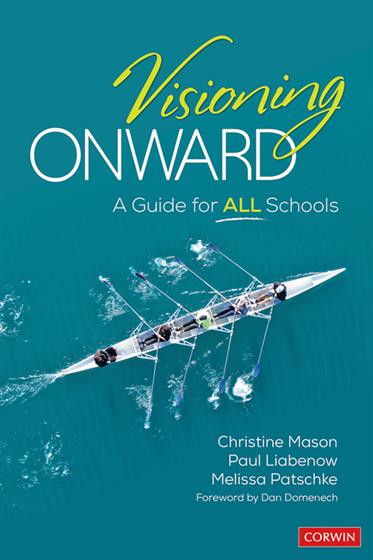List of Online Resources
Foreword by Daniel A. Domenech
Preface
Acknowledgments
About the Authors
PART I: HISTORICAL AND 21st CENTURY CONSIDERATIONS FOR VISIONING ONWARD
1. The Art of Seeing
How Leaders of Learning Transition From Believing It to Seeing It
Visioning Onward: Preparing for Challenges
What Is the Role of Schools Today?
The Opportunity That Is Opening for Schools
Why Visioning?
The Powerful Impact of Visioning
Visioning—Permission to Thrive and Change
Some Additional Considerations—In the Long Term
Conclusions—Visions and Our Day-to-Day Reality
2. Believe It to See It: Creating a Vision
Ancient Visions—Burning Cities and Prophecies
Visioning in Modern Times—Dewey to Today
Is Visioning Still Relevant in 2020?
Why Do We Encourage Schools to Embrace Visioning?
Visioning—One Secret of Uncommon Leadership
It Takes a Team
Community Building: How Much Involvement Do You Anticipate?
Factors to Consider for Visioning at Your School or District
How Do Visions Relate to a School’s Purpose?
Visioning and ESSA
Visioning in Schools—Opportunities Today to Recreate Education
Where Is Your School (Or District) Headed?
Conclusions—Visioning in a Time of Uncertainty and Implications for Schools
3. 21st Century Concerns—Food for Thought
Dreams, Visioning Onward, and Changes in Schools
Do Visions Make a Difference?
Five Great Companies
Comparing Visions
Visions as Disruptions
Visions, Missions, and Successful Ventures
How Innovations Have Disrupted Our Lives
Visioning—Various Lenses
Holistic Understanding
Group Effort
Knowledge and Values
Visions That Incorporate Many Perspectives
Visioning Is Not Missioning
Visioning Onward for School Improvement
Dreams, Visioning Onward, and Changes in Schools
Conclusions—Collectively Visioning Outside the Box
PART II: PRACTICAL CONSIDERATIONS AND STEPS TO VISIONING IN SCHOOLS
4. Visioning: Steps 1–4
Doing the Work
So How Will You Proceed With Visioning at Your School?
Some Prerequisites—Biding Time, Building Trust
An Example of Where Visions Might Take You—Green Schools
Visioning—Light-Years Beyond Ordinary (Path 1)
Another Need—Visioning to Handle a Crisis (Path 2)
Considerations for the Visioning Process
A Recommended Eight-Step Visioning Process
Step 1—Form a Vision Steering Team, and Develop a Visioning Process Blueprint
Before the Visioning Process Begins
Step 2—Identify Participants for the Visioning Process
Step 3—Develop the First Draft of Your Vision, and Imagine Your School the Way You Would Like It to Be
Step 4—Research Exemplars and Options
Conclusions—Borrowing From the Greats
Resources and Ideas to Support the How of Visioning
Iterative Visioning
5. Visioning Case Study
The Opening of a New School—Upper Providence Elementary School (UPES)
Visioning Questions for UPES
Key Questions for Parents
Thirteen Years Later—Refreshing Our Vision
Staf-faculty Focus Group Questions
UPE 5
Pro-Social Pledge
An Existing School With New Leadership at Spring City Elementary School
Spring City Staff Entry Plan Questions
Vision Questions for Spring City Staff
Conclusions—Collaboration Is Key
6. Visioning Steps 5–8
Steps 5–8
Step 5—Refine Your Vision Using an Iterative Visioning Process
Step 6—Develop Mission and Goal Statements, and Determine How to Measure Progress
Mission Statements and the Strategic Planning Process
Goals
Measuring Progress
Step 7—Secure Consensus. Ensure That You Are Communicating With Those Who Didn’t Participate or Who Have a Different Vision
Step 8—Develop an Action Plan to Implement Your Vision
How to Develop an Action Plan
Conclusions—Developing an Action Plan as a Team
7. Barriers and Sustainability
Vision, Mission, and Goals—Implementation
Lead the Visioning Journey
Obstacles on the Path
What Processes Will Be Affected?
Challenges in Implementing Heart Centered Learning
Promoting Heart Centered Learning
Implementing Visions Requires Change
You’re Not Operating in a Vacuum
Sustainability
Focus, Priorities, and Goal Setting
When Leadership Changes
Conclusions—Leveraging Communities Near and Far to Overcome Barriers to Sustainability
PART III: VISIONING AT THE MACRO LEVEL
8. Future Visioning—Here and Across the Globe
Trends in Education Affecting How Schools Operate
Change and Its Drivers
Technology and Our Way of Being and Doing
Unwanted Side Effects of Too Much Technology
Change Driver 1—Automating Choices
Change Driver 2—Civic Superpowers
Change Driver 3—Accelerating Brains
Mindfulness and Executive Functioning
Change Driver 4—Toxic Narratives
Stress
The Future of Employment
Change Driver 5—Remaking Geographies
Change Driver 6—Social Emotional and Heart Centered Learning
Heart Centered Learning
Implementing Heart Centered Learning
International Concerns and Children’s Well-Being
An Entrepreneurial Vision for Education on a Global Scale
9. Conclusion
Leadership for Tomorrow
References
Index





